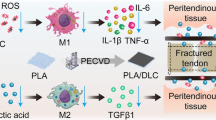Abstract
Purpose
Evaluating the effect of ABS (Ankaferd Blood Stopper®), Tranexamic Acid (Transamin®) and Thrombin-Containing Hemostatic Matrix (Floseal®) on the mental nerve of rats by using histopathologic and immunohistochemical analyses.
Materials and methods
40 Wistar Albino rats were used. Rats were randomly selected into 4 groups as Control (G1), ABS (G2), Tranexamic Acid (G3) and Thrombin-Containing Hemostatic Matrix (G4). In the control group G1, the left mental nerve was exposed and 0.3 ml of sterile saline was applied for 5 min, then closed with suture. In the other three groups, the left mental nerve was exposed and 0.3 ml ABS, Tranexamic Acid and Floseal was applied to groups, respectively. After 5 min, wounds were closed with suture. Immunohistochemical and histopathologic examinations were performed on mental nerves after 28 days.
Results
The total histopathologic and immunohistochemical semiquantitative scores were significantly higher in ABS (G2) compared to Control (G1), Tranexamic Acid (G3) and Thrombin-Containing Hemostatic Matrix (G4) (P < 0.05). Myelin thickness were significantly lower in G2 compared to G1, G2 and G3 (P < 0.05). G3 has the most reliable results compared to G2 and G4 (P < 0.05).
Conclusion
The study results suggest that ABS has neurotoxic effects and should not be used close to the nerve, and thrombin-containing hemostatic matrix should be used carefully. Tranexamic acid, on the other hand, was found to be the most reliable hemostatic agent for use in close proximity to neural tissues. Further studies are required to determine the efficacy of the hemostatic agents on peripheral nerve degeneration.





Similar content being viewed by others
References
Nakamura J (2010) Metabolic factors in the pathogenesis of diabetic neuropathy. Nihon Rinsho Jpn J Clin Med Suppl 9(24):556–561
White S (2004) Assessment of chronic neuropathic pain and the use of pain tools. Br J Nurs 13(7):372–378
Yucesoy T, Kutuk N, Canpolat DG et al (2017) Comparison of ozone and photo-biomodulation therapies on mental nerve injury in rats. J Oral Maxillofac Surg 75(11):2323–2332
Chong MS, Bajwa ZH (2003) Diagnosis and treatment of neuropathic pain. J Pain Symptom Manag 25(5):5 SUPPL. – 11
Nagamatsu M, Podratz J, Windebank AJ et al (1997) Acidity is involved in the development of neuropathy caused by oxidized cellulose. J Neurol Sci 146(2):97–102
Achneck HE, Sileshi B, Jamiolkowski RM et al (2010) A comprehensive review of topical hemostatic agents: efficacy and recommendations for use. Ann Surg 251(2):217–228
Von Arx T, Jensen SS, Hänni S et al (2006) Haemostatic agents used in periradicular surgery: an experimental study of their efficacy and tissue reactions. Int Endod J 39(10):800–808
Işler SC, Demircan S, Çakarer S et al (2010) Effects of folk medicinal plant extract ankaferd blood stopper® on early bone healing. J Appl Oral Sci 18(4):409–414
Cox S, Cole M, Mankarious S et al (2003) Effect of tranexamic acid incorporated in fibrin sealant clots on the cell behavior of neuronal and nonneuronal cells. J Neurosci Res 72(6):734–746
Echave M, Oyagöez I, Casado MA (2014) Use of Floseal®, a human gelatine-thrombin matrix sealant, in surgery: a systematic review. BMC Surg 14(1):1–13
Alkan A, Inal S, Yildirim M et al (2007) The effects of hemostatic agents on peripheral nerve function: an experimental study. J Oral Maxillofac Surg 65(4):630–634
Pampu AA, Yildirim M, Tüzüner T et al (2013) Comparison of the effects of new folkloric hemostatic agent on peripheral nerve function: an electrophysiologic study in rats. Oral Surg Oral Med Oral Pathol Oral Radiol 115(4):1–6
Altun I (2016) An experimental study of histopathologic effects of hemostatic agents used in spinal surgery. World Neurosurg 90:147–153
Carriel V, Garzón I, Alaminos M et al (2014) Histological assessment in peripheral nerve tissue engineering. Neural Regen Res 9(18):1657–1660
Oliveira AC, Garzón I, Ionescu AM et al (2013) Evaluation of small intestine grafts decellularization methods for corneal tissue engineering. PLoS ONE 8(6):e6653816
Wakita H, Tomimoto H (1994) Akiguchi I et al “Glial activation and white matter changes in the rat brain induced by chronic cerebral hypoperfusion: an immunohistochemical study.” Acta Neuropathol 87(5):484–492
Lim S, Lee J (2017) Protection of the brain through supplementation with larch arabinogalactan in a rat model of vascular dementia. Nutr Res Pract 11(5):381–387
Fedchenko N, Reifenrath J (2014) Different approaches for interpretation and reporting of immunohistochemistry analysis results in the bone tissue—a review. Diagn Pathology 9:221
Dhillon S, De Boer MT, Papacharalabous EN et al (2011) Fibrin sealant (Evicel® [quixil®/crosseal™]): a review of its use as supportive treatment for haemostasis in surgery. Drugs 71(14):1893–1915
Schwarzkopf R, Dang P, Luu M et al (2015) Topical tranexamic acid does not affect electrophysiologic or neurovascular sciatic nerve markers in an animal model. Clin Orthop Relat Res 473(3):1074–1082
Üstün R, Oğuz EK, Delilbaşı Ç et al (2017) Neuromuscular degenerative effects of Ankaferd Blood Stopper® in mouse sciatic nerve model. Somatosens Mot Res [Internet] 34(4):248–257
Iwabuchi S, Koike K, Okabe T et al (1997) Iatrogenic paraplegia caused by surgical used for hemostasis during a thoracotomy: report of a case. Surg Today 27(10):969–970
Servet E, Bekler H, Kilinçoğlu V et al (2016) Effect of bleeding on nerve regeneration and epineural scar formation in rat sciatic nerves: an experimental study. Acta Orthop Traumatol Turc 50(2):234–241
Sener I, Bereket C, Arslan G et al (2015) The effect of hemostatic agents and tissue adhesive on injured peripheral nerve healing in rats—part I. Electrophysiological study. Adv Clin Exp Med 24(1):23–29
Author information
Authors and Affiliations
Corresponding author
Additional information
Publisher's Note
Springer Nature remains neutral with regard to jurisdictional claims in published maps and institutional affiliations.
Rights and permissions
About this article
Cite this article
Adak, B.M., Laçin, N., Şimşek, F. et al. Evaluation of the effects of different hemostatic agent applications on mental nerve. Eur Arch Otorhinolaryngol 279, 5355–5362 (2022). https://doi.org/10.1007/s00405-022-07434-3
Received:
Accepted:
Published:
Issue Date:
DOI: https://doi.org/10.1007/s00405-022-07434-3




